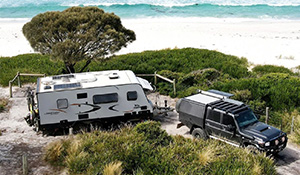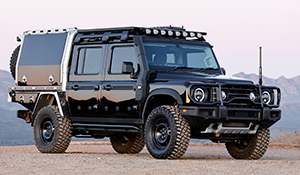2007 Honda CR-V
No longer is the CR-V pitched against other SUVs for its 4x4 ability, but now the company has come full circle and is talking up its on road prowess. This is not to say that previous models weren't good road cars as its fair to say that the hoards of buyers were not buying the compact for its off road ability. And that's the core of the matter. The majority of buyers couldn't give a hoot about the vehicle's 4x4 pretensions, and so why not make the car better on road and further satisfy this market. The theory makes sense, even though this CR-V retains the improved 4WD system that was introduced in the last generation model in 2005. To demonstrate the vehicle's new direction, the press launch drive included no dirt roads at all. Instead we were treated to a variety of everyday bitumen roads from city to country.
The new CR-V is a much improved vehicle with better build quality, interesting styling and more car-like character.
The CR-V has been sold in Australia for 10 years and in 2000 it was the top selling 4x4 light compact. Since then it has fallen from the pedestal, but remains a top selling wagon. Honda aim to lift sales by 20 percent, and to do so, has lifted specifications, but not lifted prices.
The new CR-V features a departure from previous models in the styling department, with a modern profile (below), reminiscent of the BMW X5 or Lexus RX330. Gone is the utilitarian spare wheel from the tailgate and also gone is the CR-V signature picnic table from the cargo area. The spare wheel now resides under the floor in the cargo area. Also redesigned is the side opening rear door, replaced with a full opening hatch tailgate. In many respects this model represents a quantum leap forward for the CR-V with the emphasis squarely on its car-like attributes. It is shorter, wider and lower than its predessor, but has the same wheelbase.
The third generation CR-V has been styled to satisfy the American market, and this has meant a softening of its image. The body has lost its 4x4 muscular look, replaced with smoother curved lines that aid aerodynamics, on road handling and send a new message to buyers. This is a versatile wagon, that provides the benefits of an effective all-wheel drive system, without overly trying to imitate a 4WD.
The result sees the CR-V gain a stronger, lower look. Its footprint is wider and the new double grille gives a stronger look, while there is a hint of sportiness about the curved roofline, angled side windows and full length 3 dimensional look tail lights. The CR-V is 100mm shorter, largely due to the relocation of the spare wheel, 335mm lower and 30mm lower than he previous model. Underneath its wheelbase is 5mm shorter, with the front track 30mm wider and the rear track 20mm wider.
Ground clearance has been reduced by 20mm. The body structure is more rigid and sports the safer front end frame first used on the Legend. The new platform has also reducednoise and vibration, resulting in a quieter cabin and a solid on road feel. The CR-V is offered in three models, starting with the base CR-V priced at $31,990, the Sport at $37,490 and the Luxury at $39,990. Add $2,00 for auto transmission. It is powered by a 2.4-litre four-cylinder engine i-VTEC that now produces 125kW power at 5800rpm and torque of 218Nm at 4200rpm.
To offset a 40kg increase in weight, the 6-speed manual and 5-speed automatic transmissions have been upgraded. The interior has been freshened with the gear shifter now a short throw lever protruding from the dash. The system works well, freeing up floor space. Standard equipment levels are generous with the base receiving dual front and side air bags, cruise control, air conditioning, remote locking, 17-inch steel wheels and single CD unit.
Sport models gain curtain airbags, dual zone air conditioning, 17-inch alloy wheels, sunroof, fog lamps, cargo blind, six stack CD audio and the double deck cargo shelf. The Luxury gains leather interior, heated seats, electric adjustment for the driver's seat and reverse parking sensors.The introduction of six speed manual transmission is a first for Honda, while the 5-speed auto is greatly improved, being equipped with a standard Grade Logic Control System, which improves smoothness and reduces gear hunting on steep grades.
While Honda make minimum mention of the all-wheel drive system, the drivetrain powers the front wheels in normal driving and engages the rear wheels when necessary. The system has been enhanced to react faster and deliver 20 percent more torque to the rear wheels. The system only sends power to the rear wheels when there is insufficient traction for the front wheel drive system. It consists of a conventional front wheel system, a compact transfer case that distributes torque to a propeller shaft running the length of the vehicle, a dual pump system with a multi-plate clutch, a cam unit mechanism, the rear differential and left and right rear wheel driveshafts. The core of the system is the dual pump unit. It consists of two hydraulic pumps, one driven by the front wheels via the propeller shaft and one driven by the rear wheels via the rear differential. A hydraulically activated, multi-plate clutch connects the propeller shaft to the rear differential.
If the front wheels begin to spin faster than the rear wheels - as they would on a slippery surface - the two hydraulic pumps turn at a different rate and hydraulic pressure proportional to the difference in their speeds of rotation is generated, resulting in a hydraulic pressure valve feeding the multi-plate clutch, which engages the front propeller shaft to the rear differential which then feeds the drive torque to the rear wheels. The system is virtually seamless, providing real time torque transfer. Being lower, handling and steering response has improved, with a number of small changes also contributing to the MacPherson strut front suspension. Road holding is good and there is a lack of understeer on corners, despite virtually being a front wheel drive. Cabin noise is quiet and there is noticeable cabin refinement over its predecessor. The addition of electronic stability control is also another plus for the soft roader which has greatly improved safety credentials. The engine could do with additional punch, but overall is satisfactory if the revs are kept up. This is a well balanced wagon, that is only enhanced with all-wheel drive. Towing capacity is 1500kg with a braked trailer, but only 600kg unbraked.
Brian Tanner
Specifications: 2007 Honda CR-V
Engine
Type: 2.4-litre DOHC i-VTEC
Bore x stroke: 87 x 99mm
Capacity: 2354cc
Compression Ratio: 9.3:1
Maximum power: 125kW @ 5800rpm
Maximum torque: 218Nm @ 4200rpm
Transmission
_ Manual synchronised 6-speed
_ 5-speed automatic
Manual Auto
First 3.642 2.785
Second 1.88 1.613
Third 1.212 1.081
Fourth 0.972 0.772
Fifth 0.78 0.566
Sixth 0.659 -
Reverse 3.583 2.000
Final Drive Ratio 5.333 4.500
Realtime four wheel system.
Suspension
Front: MacPherson strut
Rear: Multi-link double wishbone
Brakes
Front: Ventilated disc
Rear: Disc
Parking brake: foot operated
Steering
Type: Rack &?pinion
Turns lock to lock: 2.96
Turning circle: 11.8 metres
Dimensions
LxWxH: 4250 x 1820 x 1680mm
Wheelbase: 2620mm
Ground clearance: 185mm
Towing - Manual Auto
Braked 1500kg 1500kg
Unbraked 600kg 600kg
Fuel tank capcity: 58 litres
RRP: CR-V - Man $31,990, Auto $33,990
CR-V Sport - man $37,490, Auto $39,490
CR-V Luxury - Man $39,990, Auto $41,990













